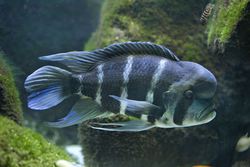The evolution of cichlid fish
The direct link between DNA variation and species diversity is not a clear one, despite decades of research on the topic. Cichlid fish, found in the East African Great Lakes, are very useful organisms to study this relationship due to their broad natural variation. The EU-funded INTERGENADAPT (The interaction and the genetic basis of naturally versus sexually selected traits in the adaptive radiations of cichlid fishes) initiative studied the link between cichlid genes and several physical traits that have evolved in some of these species. Researchers looked for the genetic variation behind thick lips, specific jaw shapes and 'egg-dummies', markings that males of certain species have on their fins. The project sought to identify the evolutionary pressures (e.g. natural or sexual selection) that resulted in these traits evolving in some species. INTERGENADAPT found that for body and jaw shape, convergent evolution has occurred many times in the same ecological niche (i.e. Lake Tanganyika). This goes against the widely-held belief that similar forms do not naturally coexist. The other major finding from this research was that similar sets of genes evolved to produce these outcomes, even though they evolved independently. INTERGENADAPT has contributed to scientists' understanding of the mechanisms of evolution, and demonstrated the value of cichlid fish as a model species.







